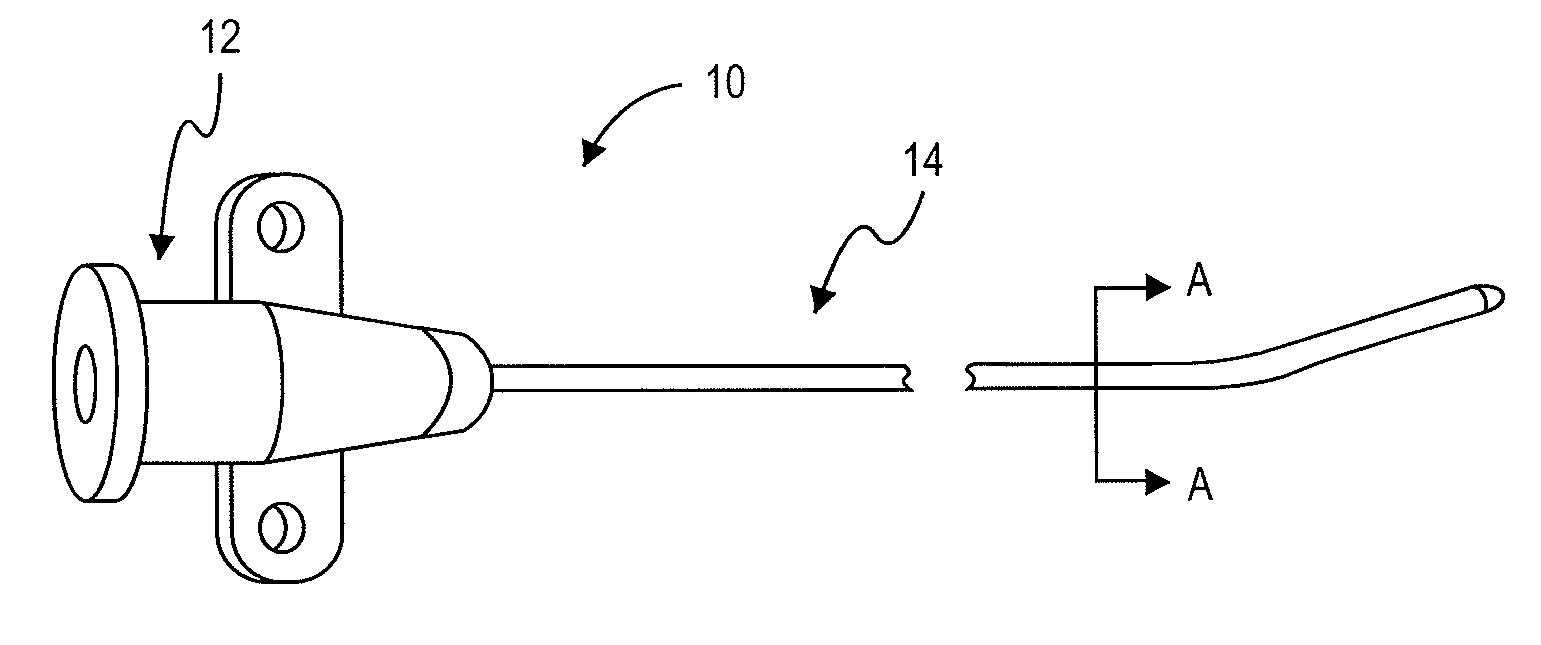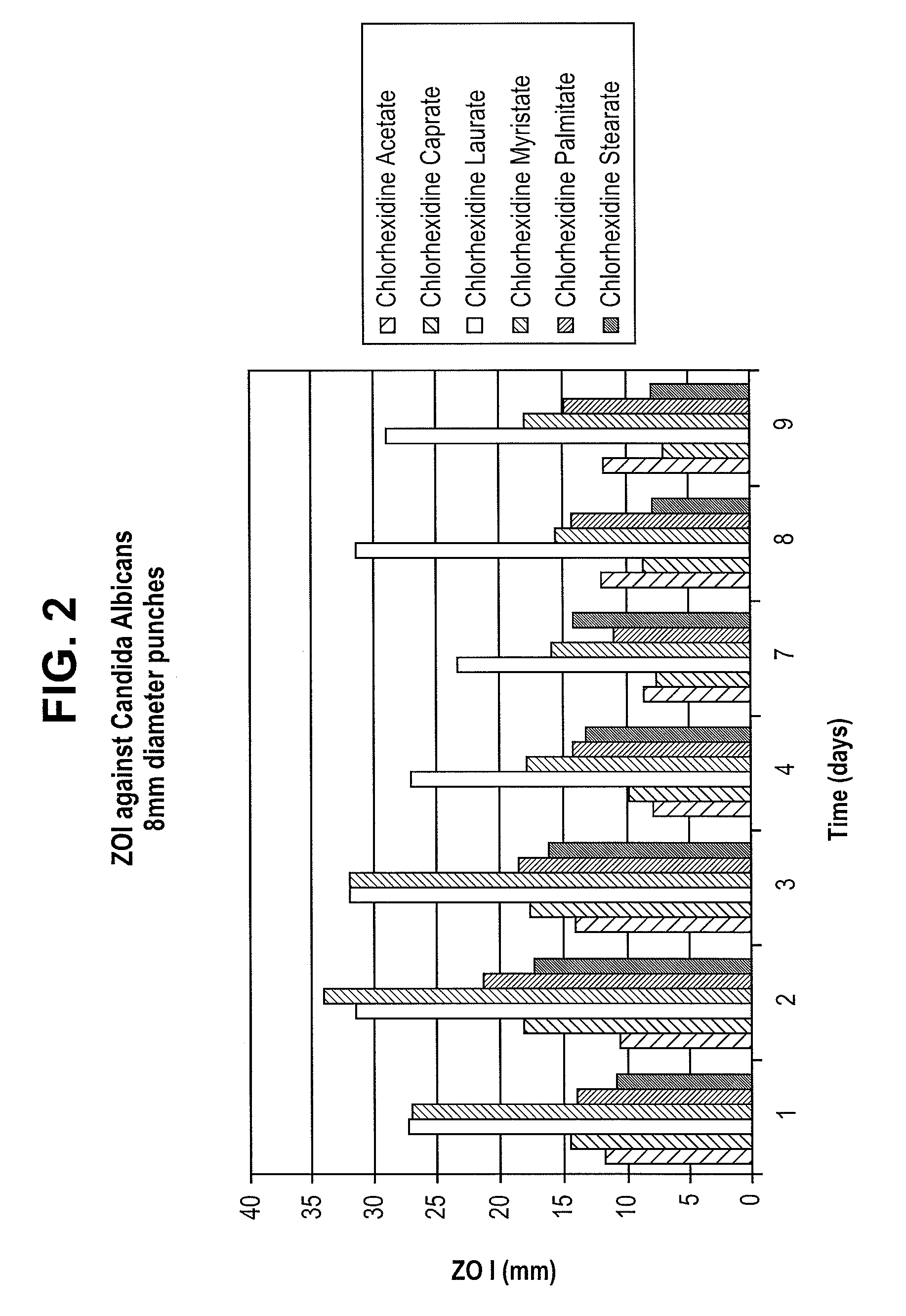Elastomeric Devices Containing Chlorhexidine/Fatty Acid Salts Made From Fatty Acids of 12 to 18 Carbons
a technology of elastomeric devices and chlorhexidine, which is applied in the direction of biocide, prosthesis, catheters, etc., can solve the problems of burdensome replacement and no longer retain antimicrobial properties of devices, and achieve the effect of optimizing infection resistance and optimizing infection resistan
- Summary
- Abstract
- Description
- Claims
- Application Information
AI Technical Summary
Problems solved by technology
Method used
Image
Examples
example 1
[0030]To synthesize the various chlorhexidine / fatty acid salts, 2.1 molar equivalent of capric acid (decanoic acid, Sigma-Aldrich), lauric acid (dodecanoic acid, Sigma-Aldrich), myristic acid (tetradecanoic acid, Sigma-Aldrich), palmitic acid (hexadecanoic acid, Sigma-Aldrich), and stearic acid (octadecanoic acid, Sigma-Aldrich), were added to individual slurries of 15.1 g chlorhexidine base (Arrow International, Reading, Pa.) in 150 ml of alcohol (Fisher Scientific). Solution went clear and then precipitation occurred. Precipitate was rinsed with 100 ml alcohol and filtered twice, after which it was vacuumed dried at 25° C. for 24 hrs.
TABLE 1% recovery of precipitated chlorhexidine / fatty acid saltSample ID% recoveryChlorhexidine Caprate74.0Chlorhexidine Laurate88.7Chlorhexidine Myristate98.1Chlorhexidine Palmitate92.4Chlorhexidine Stearate97.2
example 2
[0031]A solution of each respective chlorhexidine / fatty acid salt was prepared and used to infuse a sample of elastomeric material. To perform the test, individual samples, 8 cm pieces of polyurethane tube containing a colorant, were surface dip coated in respective solutions of the chlorhexidine / fatty acid salts. The solutions were prepared as follows: 8.6 g of Tecoflex (Noveon, Cleveland, Ohio) was dissolved in 174 g of Tetrahydrofuran and methanol. 5.88 g of chlorhexidine acetate, chlorhexidine laurate, chlorhexidine myristate, chlorhexidine palmitate and chlorhexidine stearate were individually dissolved into the polymer-solvent mixture. The samples were immersed into the solvent-polymer-salt mixture and then dried at room temperature, evaporating the solvent. A polymeric coating was produced on the surface of the tubes. The amounts of chlorhexidine / fatty acid salt adhered per cm of the tube was measured (Table 2) by exhaustively extracting the salt and measuring UV absorbance a...
example 3
[0033]For each of the samples, the rate of release of chlorhexidine / fatty acid salts into an aqueous solution was determined. To perform the rate of release test, 1 cm from each of the coated polyurethane tubes, were submerged in DeIonized (DI) water and incubated at 37° C. for a period of 28 days to determine the rate of release of the salts from the respective 1 cm samples of coated polyurethane tubing. The water was collected and replaced with fresh water after approximately 2 hours. The water was again collected and replaced with fresh water after the first day and every seven days thereafter. The amount of chlorhexidine / fatty acid salt in the collected water was measured with an Agilent 8453 UV-Vis Diode Array Detector with a manual setup using a cuvette w / path length of 1 cm. Chlorhexidine absorbance was read at 253 nm and concentration was calculated via a calibration curve developed using standards of 1, 5, 10, 20, 30, 35, and 40 μg / mL chlorhexidine acetate in DI Water.
[0034...
PUM
| Property | Measurement | Unit |
|---|---|---|
| path length | aaaaa | aaaaa |
| concentration | aaaaa | aaaaa |
| concentration | aaaaa | aaaaa |
Abstract
Description
Claims
Application Information
 Login to View More
Login to View More - R&D
- Intellectual Property
- Life Sciences
- Materials
- Tech Scout
- Unparalleled Data Quality
- Higher Quality Content
- 60% Fewer Hallucinations
Browse by: Latest US Patents, China's latest patents, Technical Efficacy Thesaurus, Application Domain, Technology Topic, Popular Technical Reports.
© 2025 PatSnap. All rights reserved.Legal|Privacy policy|Modern Slavery Act Transparency Statement|Sitemap|About US| Contact US: help@patsnap.com



